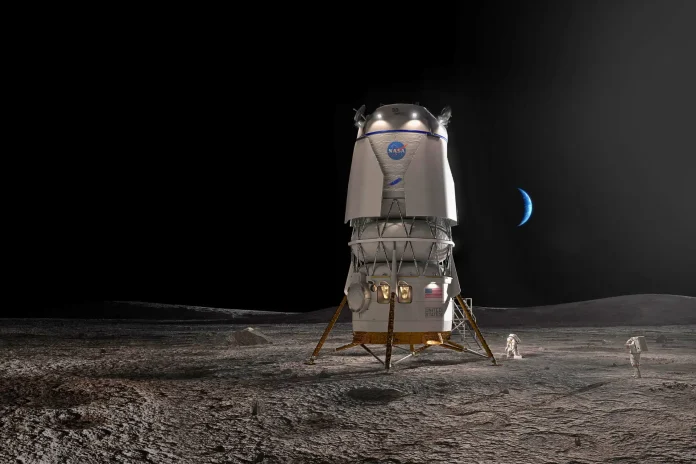The lunar dust is stirring once more with the competition of Starship and Blue Moon Lander. After decades of silent solitude, the Moon might interact with humanity again, this time with a renewed ambition: sustained exploration and, perhaps, even a permanent lunar base. NASA’s ambitious Artemis program stands at the forefront of this adventure, with two mighty lunar landers competing to carry astronauts back to the lunar surface – SpaceX’s Starship and Blue Origin’s Blue Moon lander.
The last time humans walked on the Moon was in 1972, during the final mission of the Apollo program. For half a century, the lunar surface has remained untouched by human footprints, a proof of the immense technological challenges of space travel. But the tide is turning with advancements in rocketry, materials science, and life support systems. NASA’s Artemis program aims to establish a “sustainable human presence on the Moon,” laying the groundwork for future missions to Mars and beyond.
Blue Moon Lander
Blue Moon lander is not a single spacecraft but rather a family of landers designed to carry both cargo and astronauts to the Moon. The Mk1 version is a robotic workhorse capable of delivering up to 3 tons of payload to the lunar surface. It’s already in testing, with its first uncrewed mission to the Moon targeted for as early as 2024.
But the show’s true star is the Mk2 Blue Moon lander, the chosen carrier for NASA’s Artemis 5 mission. It stands 16 meters tall and weighs over 45 tons, overshadowing even the iconic Apollo Lunar Module. Its spacious interior can accommodate four astronauts on the lunar surface for up to 30 days, providing them with a comfortable and well-equipped home away from home.
Power of Blue Moon Lander
The Blue Moon Lander is amazingly engineered and packed with cutting-edge technology to ensure a safe and efficient lunar journey, like:
- BE-7 Engine: This powerful engine utilizes liquid hydrogen and liquid oxygen propellants, offering high thrust and efficiency for both descent and ascent from the Moon.
- Autonomous Landing System: Equipped with advanced sensors and software, the Blue Moon can precisely navigate and land on even the most challenging lunar terrain.
- Docking Capability: The lander can smoothly dock with the planned Gateway lunar space station, enabling crew and cargo transfer and extending mission durations.
- Radiation Shielding: The cabin is shielded from harmful cosmic radiation, protecting the astronauts during their extended stay on the Moon.
Journey From Artemis 5 and Beyond
The Artemis 5 mission, currently slated for no earlier than 2029, will be a landmark moment in human history. It will mark the first crewed landing on the Moon since Apollo 17 and pave the way for further exploration in the coming decades. Blue Moon’s role in this journey is essential, offering a reliable and versatile platform for astronauts to conduct scientific research, deploy lunar infrastructure, and gather invaluable data for future missions.
Beyond Artemis 5, the Blue Moon program has ambitious plans for the future. Potential applications include:
- Construction of a permanent lunar base: Blue Moon could support the establishment of a long-term lunar outpost, facilitating scientific research, resource extraction, and even tourism.
- Gateway station expansion: The lander’s docking capabilities could be vital in constructing and servicing the Gateway lunar space station, a central hub for future deep space exploration.
- Enabling commercial lunar activities: Blue Moon’s cargo capacity could open doors for private companies to conduct lunar research, resource mining, and even space tourism ventures.
A New Era of Lunar Exploration
With SpaceX’s Starship and Blue Moon lander competition for lunar supremacy, a new era of space exploration is upon us. This healthy competition drives innovation, reduces costs, and ultimately benefits the advancement of space technology. Whether it’s Blue Moon or Starship that touches down first, the ultimate victor is humanity, taking another giant leap towards our cosmic destiny.



